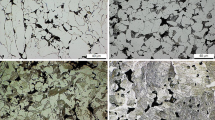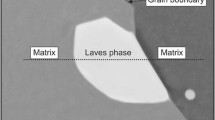Abstract
The effect of mechanical activation of heat-resistant steel 55Kh20N4AG9 powders on the structure and properties of high-density material obtained by dynamic hot pressing with extrusion elements was investigated. Mechanical activation improves the chemical homogeneity of the highly alloyed material, decreases the particle size of the strengthening carbonitride phase, promotes its interaction with dislocation tangles and increases their thermal stability. Mechanical activation of powders with intermediate anneals promotes the accumulation of thermally stable defects in the crystal structure and leads to the accelerated formation of a cellular fragmented structure in the austenite, characterized by a high dislocation density in block walls. The developed cellular fragmented substructure is retained after dynamic hot pressing and subsequent heat treatment, and elevates the mechanical properties of the high-density heat-resistant powder metallurgy steels.
Similar content being viewed by others
REFERENCES
K. A. Verner, V. V. Mikheeva, V. D. Zelenova, et al., “Investigation of the effect of heat treatment on the properties of steel 55Kh20N4AG7 exhaust ports of internal combustion engines,” Trans. N.-E. Avtomotornogo Inst., 1987, 34–41 (1982).
Yu. G. Dorofeev, Dynamic Hot Pressing in Metalloceramics[in Russian], Metallurgiya, Moscow (1972).
Yu. G. Dorofeev, Dynamic Hot Pressing of Porous Powder Ingots[in Russian], Metallurgiya, Moscow (1977).
Ya. D. Vishnyakov, Contemporary Methods for Investigating the Structure of Deformed Crystals[in Russian], Metallurgiya, Moscow (1985).
V. S. Postnikov, Internal Friction of Metals[in Russian], Metallurgiya, Moscow (1974).
M. L. Bernshtein, V. A. Zaimovskii, and L. M. Kaputkina, Thermomechanical Treatment of Steel[in Russian], Metallurgiya, Moscow (1983).
D. M. Karpinos, L. I. Tuchinskii, and L. R. Vishnyakov, New Composite Materials[in Russian], Vysh. Shk., Kiev (1977).
Author information
Authors and Affiliations
Rights and permissions
About this article
Cite this article
Dorofeev, V.Y. Structure and Properties of Heat-Resistant Steels Obtained from Powders after Mechanical Activation. Powder Metallurgy and Metal Ceramics 41, 593–598 (2002). https://doi.org/10.1023/A:1022932219718
Issue Date:
DOI: https://doi.org/10.1023/A:1022932219718




